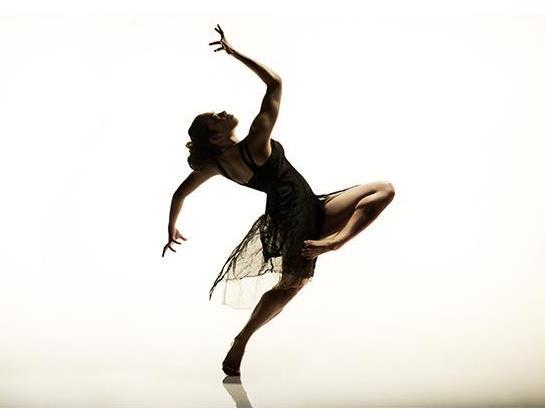Nicola Sabatino in Bangarra OUR Land People Stories. Photograph by Edward Mulvihill.
The haunting sobs of women mourning the loss of the D’harawal people murdered in the Appin massacre opens the first piece Macq for Bangarra’s 2016 production.
Jasmin Sheppard’s take on Lachlan Macquarie’s initial overtures to the native population, culminating disastrously in the 1816 genocide where Western Sydney now sits, is confronting; especially so considering the exposition that this act of war is now barely remembered in modern day Parramatta. The caricatured settlers marching past a long white table representing the annual Durbur picnics starkly contrast with the nimble, fluid moves of the locals.
Used as the definitive set piece on the sparsely decorated stage, the banquet table is the dividing line between the populations as native faces off against non-native at opposite ends of the table. The agility of the Aboriginal population, in its attempt to escape European subjugation, is demonstrated as the indigenous warrior scurries away from the governor on the underside of the table in a gravity-defying manoeuvre.
As Sheppard’s debut full length piece, the choreography is suggestive of a potential avant-garde approach for the future direction of the company. The fast-paced, eclectic dance moves possibly portend a more erratic direction to be led by the next generation of choreographers. The sheer talent and skill of the dancers is no less on display with Sheppard’s original artistic style which blends contorted poses with prolonged moments of reflection, such as the scene where limp bodies gradually descend in passing to the floor.
The musical score resonates with the iconic sounds of the late David Page; his pulsating rhythms distinguishing so many of Bangarra’s works. Interspersed throughout the score, excerpts of Macquarie’s diary are broadcast, describing his impressions of the Aboriginal population and ultimate massacre. These depictions, and the chilling sounds of women lamenting, complement the soundtrack and spectacle, blending together the story of New South Wales’ governor in a reflective but not accusatory work.
The differing styles of each of the choreographers is evident across the suite of works. In Miyagan, the scene then shifts to a more traditional setting. The second dance explores traditional ties, paralleling the experience of two cousins, Beau Dean Riley Smith and Daniel Riley, who discovered their familial ties after joining Bangarra. While the narrative of this piece is more simplistic than the journey traced by the beginning and end works, the opportunity to be entranced by the visual spectacle is no less compelling.
The emphasis on family is evident in the collective dance displays, which draw in the entire troupe as a group rather than focusing on the leads. There is the sense of a corrobboree as the performers circle the stage around a fire, celebrating the coming together of a community. The set design by Jacob Nash is impeccable and blends seamlessly with Matt Cox’ lighting to creative a visually stunning spectacle. The kinship theme is symbolically evident in the culmination of giant overlapping branches of emu feathers suspended from the ceiling, gradually accumulating to form a nest. Were it not for Paul Mac’s more modern electronic rhythms, it would be easy to imagine this dance as taking place thousands of years ago.
The post-interval piece of Nyapanyapa also celebrates the life of painter Nyapanyapa Yunupingu. The final piece is a polished, complete work that epitomises the carriage of storytelling through dance. Here art celebrates art as prolific choreographer Stephen Page depicts the life of the renowned Yolngu woman. Tracing the story of her life, the performance starts by recreating the setting of North East Arnhem Land where Nyapanyapa was traumatically attacked by a buffalo. The other animals of Arnhem Land, emus, fish and dogs are all masterfully recreated with a style that uncannily mimics the movement of the various fauna.
Jennifer Irwin’s costume design, as it has been throughout all the works, instinctively captures the essence of the performers and her buffalo outfit, embellished with two gigantic horns, is no less spectacular. A series of shifting murals form the background and accompany the changing outfits that progressively become more modern with an outstanding array of colours. As Nyapanyapa grows and is introduced to more contemporary influences, such as rock music, the tempo shifts abruptly and a change of pace takes over the soundtrack, accompanied by a brighter visual backdrop.
The ‘Wendy puppets’ appear instantaneously on stage and tower over the dancers like humongous shadows through which the dancers weave in and out. Elma Kris, who plays Nyapanyapa, shows her theatrical skills in acting as well as dance, wandering through each scene with an expression channelling the inner strength of the ground-breaking painter. In the closing scenes, the dancers drift as one, painting plumes of smoke in the air from long poles tracing arcs upon the ceiling. In one of the most mesmerising spectacles of the show Stephen Page again demonstrates his amazing ability to manipulate props with dance moves, creating a transformative experience reminiscent of an ancient culture.
As Bangarra struggles to reconcile the loss of David Page, whose partnership with his brother is part of what made the company such a resounding success, there is a sense that OUR Land People Stories heralds a shift in direction for the company. With a portrayal of culture that is uniquely Australian, Bangarra is now firmly planted on the world stage as an international success story. In the way that Bangarra itself has come to symbolise the successful fusing of indigenous cultural traditions with modern interpretations of art, OUR Land People Stories is evocative of the journey that the company has embarked upon and will continue to travel for many generations.
Rating: 4 stars out of 5
OUR Land People Stories
Playing at Canberra Theatre
Choreographers: Jasmin Sheppard, Beau Dean Riley Smith & Daniel Riley, Stephen Page
Bangarra Dance Theatre
28 – 30 July 2016





